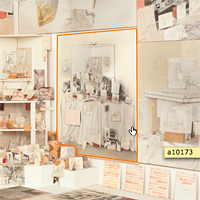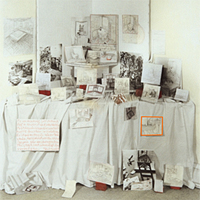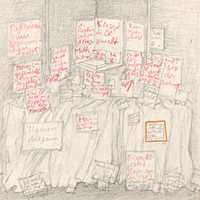























Anna Oppermann’s Ensembles at the Hamburg Kunsthalle
The team headed by Martin Warnke at the Leuphana University, Lüneburg, developed and tested the PeTAL annotation technology used in HyperImage on selected ensembles from artist Anna Oppermann. In particular, these included ‘Öl auf Leinwand’ (Oil on Canvas), ‘MKÜVO’ and ‘MKÜVO-Fensterecke' (Corner Window). The results of this structured documentation was published as a Macromedia application on DVD in 2004. Since the beginning of 2009, this has been converted to the HyperImage technology (the process is still on-going).
As well as its simple, easy-to-use handling compared to its predecessor, HyperImage provides many more opportunities to map the multitude of links that the ensembles offer. The light table function is a new tool for the user.
The image-in-image structure of referencing is self-evident as is the application’s main navigation element. In addition, annotation texts can now be increasingly used to enhance the ensemble material: in fact, all element types (groups, objects, views, layers, light tables) can be appended with such annotations. Because links can be built into annotation texts, it is possible, for example, to have two different links references from any one single layer.
Here an example from the application. A mouse-click on one of the
sensitive areas of the sketch opens the artist’s transcribed
text, while the link from the annotation text of the layer takes
the user to the element that serves as the project area for this
text.
An example in the Web publication 
In addition to the navigation options described above, Groups displays
the ensemble material combined and structured in line with a wide
variety of criteria. For instance, all structural elements within
an ensemble can be retrieved.
An example in the Web
publication 
Light tables also make it possible to group material from the ensemble,
but not necessarily in the form of a range of thumbnail-sized images.
Using light tables, images can be freely positioned on the monitor
in any size whatsoever. On top of this, it is also possible to
select details. Light tables are an ideal tool to make direct comparisons
between images that have been added by the author as well as those
added later by users. The author’s light tables are securely
anchored in the application and are to be found under Gallery > Public
Light Tables. In contrast, the user’s light tables are stored
on the hard disk and can be retrieved by clicking Gallery > Private
Light Tables.
An example in the Web
publication 
The Back References function displays image-based context of linked
elements. These are analogous to concordance in a text culture
and make it possible to reconstruct the artist’s methodology – here
Anna Oppermann’s – from the ur-cell to a whole ensemble
that has developed to include several hundred elements in the course
of time.
Carmen Wedemeyer, Leuphana University, Lüneburg